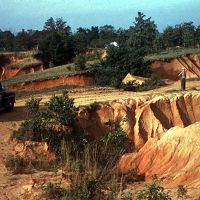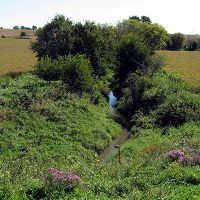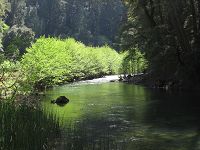Introducing Eel River CZO
03 Mar 2014
News Source: Berkeley News Center (By Robert Sanders)
UC Berkeley scientists will receive $4,900,000 over the next five years to study the Eel River watershed in Northern California...
What the researchers uncover will help improve global climate models and modeling tools that can be used by state or regional decision makers to guide planning. Their discoveries may eventually allow scientists to predict the impact of changing climate and land use on future droughts, floods and supplies of water for drinking and agriculture.
Funded by the National Science Foundation, the Eel River Observatory is one of four new Critical Zone Observatories that received grants late last year, bringing the total number of such observatories to 10. All focus on the so-called “critical zone”: the thin veneer of Earth, from the bottom of the groundwater to the tree tops, that is critical to aquatic and terrestrial life as the source of fresh water and site of soil formation from rock.
The Eel River is increasingly under pressure because of illegal marijuana cultivation, wine grape growing and other uses that extract water from the river and threaten one of the state’s largest Coho salmon runs. In addition, warming waters in recent years have led to outbreaks of blue-green algae that produce enough toxins to kill dogs that drink the water. The river is currently stressed by the driest winter in decades.
“Whatever the agricultural use in the future, we will see increasing demands on a decreasing water resource,” said observatory director William Dietrich, UC Berkeley professor of earth and planetary science and an expert on the processes that shape landscapes.
For the full article please visit here: http://newscenter.berkeley.edu/2014/01/15/eel-river-observatory-seeks-clues-to-watersheds-future/
By Robert Sanders
News Source:
READ MORE from Berkeley News Center (By Robert Sanders) >>
News Category:
RESEARCH
Publications
2013
The Eel River Critical Zone Observatory: exploring how the critical zone will mediate watershed currencies and ecosystem response in a changing environment. Dietrich, WE, JK Bishop, SM Carlson, ME Power, and S Thompson (2013): NSF Proposal
Related News

New CZOs formally unveiled
17 Jan 2014 - The National Science Foundation formally announced the funding of four new Critical Zone Observatories to be added to expand the network to a total...

Introducing Calhoun CZO
03 Mar 2014 - The Calhoun CZO seeks to understand how Earth’s Critical Zones respond to and recover from severe erosion and land degradation.

Introducing Intensively Managed Landscapes (IML) CZO
03 Mar 2014 - The IML-CZO focuses on intensely managed agricultural and urban landscapes in Iowa, Illinois, and Minnesota.

Introducing Reynolds Creek CZO
03 Mar 2014 - New Reynolds Creek CZO leverages USDA ARS spatial and temporal hydroclimate data to improve prediction of soil carbon and critical zone processes
Explore Further

